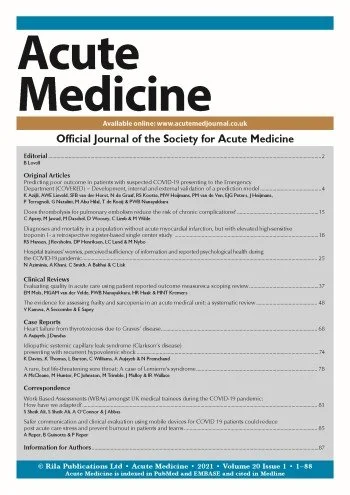
Long ago, I wanted to be an Orthopaedic surgeon. I got into the habit of publishing and never looked back!
#publishorperish
Please see below for a description and links to publications that I am named in.
-

Lifestyle Management in Type 2 Diabetes
Lifestyle management is a key component of care when managing patients with type 2 diabetes (T2D). With appropriate alteration to lifestyle it is possible to significantly improve T2D and achieve remission. This article aims to give an overview of the evidence and recommendations on body composition, diet, smoking, alcohol and exercise. It will also cover consultation techniques and resources available to improve care.
-

Veterans’ Health
Military veterans provide an interesting dynamic to consultations. The stresses that are placed upon them are different to those on the general population. The veteran may have an extensive past medical history that has led them to return to civilian life and needs to be carefully explored. This article aims to cover specific mental health, physical health, and administrative issues that may arise when consulting with veterans. Better understanding of these medical issues may help improve health and transition into civilian life for military veterans.
-

A guide to managing anaphylaxis for General Duties Medical Officers
IAnaphylaxis is a severe, life-threatening, generalised hypersensitivity reaction. It affects 1 in 1,333 (~0.08%) of the English population during their lives, with 1% of cases being fatal. Management, underpinned by guidance from the Resuscitation Council (UK), focuses on a thorough clinical assessment and prompt administration of intramuscular adrenaline. Symptoms may recur, so patients must be observed for a period of no less than six hours. In a deployed environment evacuation must be swift and into a safe environment capable of providing critical care support. There are clear occupational implications following a case of anaphylaxis, and a confirmed case may affect service personnel’s fitness to deploy. This article will summarise the management of anaphylaxis in Royal Naval personnel.
-

Managing Labour with a History of Exercise Induced Anaphylaxis
We describe a case of a 23-year old female with known Exercise Induced Anaphylaxis (EIA) and management of her labour. EIA is a rare condition characterised by an allergy triggered by exertion [ [1] ]. Little is known about the condition but symptoms tend to stabilise throughout life and symptoms are controlled by modification of exercise and avoidance of precipitants.
-

Improving the safety of patient transfer from AMU using a written checklist
Unsafe patient transfers are one of the top reasons for incident reporting in hospitals. Criteria guiding safe transfer have been issued by the NHS Litigation Authority. To meet this standard, a "transfer check list" was redesigned for all patients leaving the Acute Medical Unit (AMU) in the Heartlands Hospital. Following the introduction of the checklist two full audit cycles were conducted. The first cycle highlighted an extremely poor uptake of the checklist. After interventions to educate nursing staff and raise awareness of the issues at the regular staff meetings, re-audit demonstrated significant improvement in completion rate. Subsequent monitoring indicates continued improvement, with compliance up to 95% for completion of the transfer checklist on AMU. Incident reporting relating to transfer has also decreased significantly.
-

A potential addition to continuing professional development points
Description goes here -

Can Physiotherapists recognise Cauda Equina Syndrome (CES) better than doctors?
Objectives
To assess health care professional's knowledge with regards to the urinary symptoms of CES and when treatment should be offered.
Background
Recent articles in the medical press highlight the potential dangers of Cauda Equina Syndrome (CES). CES has the highest rates of litigation due to its long-term neurological impairment.
Method
A 4-part questionnaire was given to 60 professionals. The participant was asked to rank 15 urinary symptoms, 7 of these symptoms were not related to CES, also the ideal time to surgical intervention for Complete CES and Incomplete CES.
Results
A total of 44 questionnaires were analysed. CES symptoms were ranked significantly higher than then non-CES symptoms. The physiotherapists rated the CES symptoms significantly higher than the doctors (P = 0.05) and on average rated the non-CES symptoms significantly lower than doctors (P < 0.05).
87.8% thought that complete CES should be treated < 24 hours and 9.76% thought that complete CES should be treated from 24-48 hours. 46.34% thought that CESI should be treated < 24 hours and 43.9% thought that CESI should be treated from 24-48 hours.
Conclusion
These results demonstrate that physiotherapists are better than Doctors at identifying the urinary symptoms in CES. The majority of health care professional who took part in this study stated that they would offer surgical intervention for both Complete and Incomplete CES within 24 hours. The gap in knowledge highlights the need for education to all medical professionals in the symptoms of CES and also the timing of treatment.
